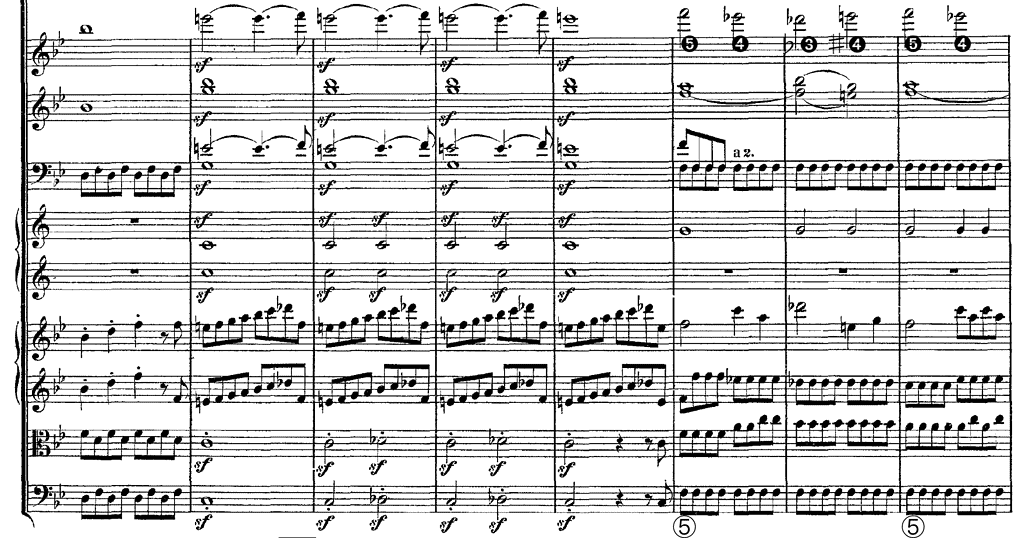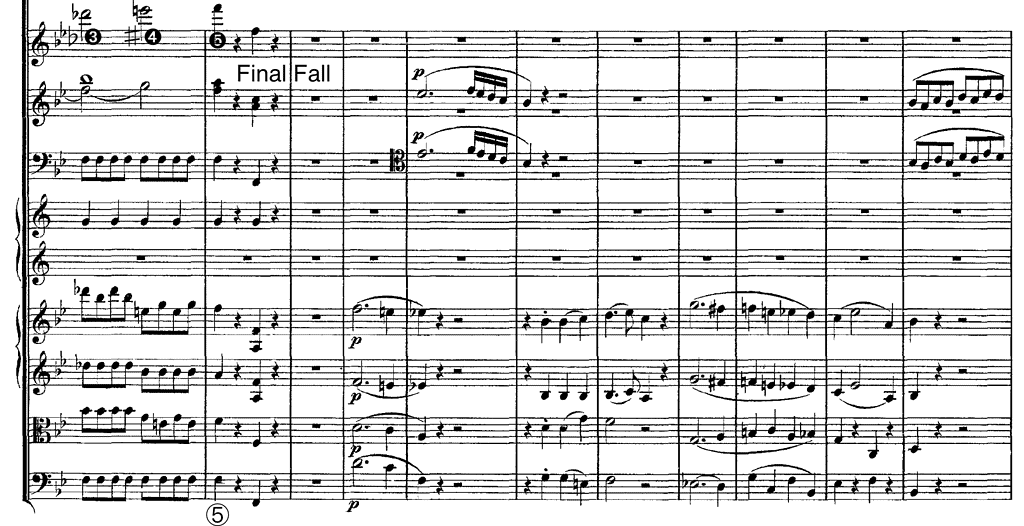As we saw in my essay The Quiescenza: The Basics, a Quiescenza is a tonic pedal point with four or five sonorities, 5/3 – [7♭/5/3 –] 6/4 – 7(♮)/4/2 – 8/5/3, and a ➎–➏–➐–➊ or ➊–♭➐–➏–(♮)➐–➊ treble line that can be used as a proposta schema or occur in a closing passage.
In this essay, I will examine three other types of Quiescenza: the Quiescenza with a ➊–➐–♭➐–➏–➐–➊ treble line, the hermaphrodite Quiescenza (including ♭➏) and the Quiescenza-Ponte (a Quiescenza in the dominant).
To facilitate the reading of this essay, I use Robert Gjerdingen’s black-circled figures to indicate scale steps in the melody (e.g. ➍–➌) and white-circled figures to indicate scale steps in the bass (e.g. ⑦–①). And I add an accidental to a figure when the specific designation of a diatonic or a chromatically altered scale step is required, although this symbolized notation can differ from the actual one. The list below should suffice to make the system of indications clear. Regardless of the mode,
♭③ always refers to the scale step a minor third above ①
③ always refers to the scale step a major third above ①
♭⑥ always refers to the scale step a minor second above ⑤
⑥ always refers to the scale step a major second above ⑤
♭⑦ always refers to the scale step a major second below ①
⑦ always refers to the scale step a minor second below ①
Note further that ‘Bar 1a’ refers to the first half of bar 1, ‘bar 1b’ to its second half.
The Quiescenza With ➊–➐–♭➐–➏–➐–➊
As we have seen in my essay The Quiescenza: The Basics, the treble line of a Quiescenza often begins with a ➊–♭➐ snippet. However, if a more chromatic treble line is desired, ➐ can be inserted between ➊ and ♭➐. This version is illustrated in the following example, which shows a pair of Quiescenzas with a ➊–➐–♭➐–➏–➐–➊ characteristic line, Quiescenzas functioning as a postcadential formula of a clausala basizans, heading towards the end of the exposition:

Note further
- how the pair of Quiescenzas is introduced by the typical trill on ➋ in bar 72b, in this case accompanied by a trill on ➐ a third lower
- that the characteristic upper line of the Quiescenzas begins in the upper part of the left hand of the first piano and is taken over by the right hand of both pianos in octaves
- the typical counterpoint ➊–➋–➌–➍ that accompanies the ➊–➐–♭➐–➏ snippet (bars 73–74a and 75–76a)
- the insertion of a 6/4/2 sonority (with B) between the 6/4 and 7/4/2 sonorities (bars 74 and 76)
One can better appreciate the brilliance of Mozart’s version if one renders ‘normally’, as I have done here:

This hypothetical version works well, but clearly lacks the individuality of the original.
The Hermaphrodite Quiescenza
If a Quiescenza is used in a major key, it can still include ♭➏ —the hermaphrodite note— instead of ➏. While Gjerdingen calls this type the “darker version of the Quiescenza”, I prefer to use the term “hermaphrodite Quiescenza” to be consistent with the term “hermaphrodite Fonte”. (As I discuss in my essay The Fonte: The Basics, the hermaphrodite note can be included in the second segment of a Fonte, resulting in a hermaphrodite Fonte.) If present in a Quiescenza, the hermaphrodite note ♭➏ is usually added to the 7/4/2 chord. Two pairs of hermaphrodite Quiescenzas occur in the well-known opening Allegro of Beethoven’s ‘Spring’ Sonata for piano and violin in F major op. 24, one pair in the closing passage of the exposition, the other in the closing passage of the recapitulation. The following example shows the latter (which is followed by an extensive coda):

Allegro, bars 193–202
The Quiescenza-Ponte
While all the Quiescenzas we have seen so far are based on a tonic pedal point —one of the characteristics of this schema, the same harmonic progressions can also occur at the level of the dominant with a ➎–➍–➌–♯➍–➎ treble line above a dominant pedal point, a variant that Vasili Byros has christened a Quiescenza-Ponte (Trazom’s Wit (2013), p. 221 & 246). By adding the term Ponte (Italian for bridge) to the label, Byros refers to a label coined by Joseph Riepel (1709–1782). For the latter, a Ponte
- serves primarily as an alternative to a Fonte or Monte
- acts a bridge leading back to the tonic key area
- relies heavily on dominant harmonies, but does not necessarily contain a dominant pedal point.
Schemata theorists, including Byros, however, often use the term Ponte (slightly) differently: as a dominant pedal with postcadential (dominant) function. In any case, the Quiescenza-Ponte with both structural functions is used in galant repertoire. The following example illustrates its use as the prolongation of a halve cadence. While the key of the movement (and the symphony) is G minor, the local key of the excerpt —the end of the transition and the start of the second theme of the exposition— is B flat major.


As when a Quiescenza is used to close a section, the Quiescenza-Ponte occurs here twice in succession, with the end of the first coinciding with the beginning of the second (bars 38–42).
While one could indeed argue that the key of this entire excerpt is B flat major, the halve cadence that concludes the transition has some tonal ambivalence, with several features contributing to a potential perception of F major:
- The length of the pedal point on c: bars 39–42 repeatedly focus on a C dominant seventh chord.
- Not a single D but multiple appearances of D♭ occur in bars 34–41, which is more likely to be heard as ♭⑥ and ♭➏ in F major than as ♭③ and ♭➌ in B flat major, and which could be called the hermaphrodite note. Note how the characteristic treble line of both Quiescenza-Pontes (here in the flute part, which is the upper stave) results in an augmented second.
Note further that the second Quiescenza-Ponte concludes with a Final Fall.
(The Ponte will be discussed in a separate series of essays.)
In the following example, an excerpt from a violin sonata by Pierre Gaviniés (1728–1800), a pair of Quiescenza-Pontes is used as an individual structural building block that bridges from a passage in D major to the recapitulation of the main theme of the minuet in G major, a structural function probably more in line with Riepel’s original concept of the Ponte.

As I explain in my article Yet Another Galant Schema: The Dominant Pedal Accompanied by a Chromatic Descent from 2022, a dominant pedal point that follows a passage in the dominant key and leads back to a passage in the tonic key is tonally ambivalent. Do you hear the Quiescenza-Pontes in D major as a consequence of the preceding passage in D major or do you hear them in G major, anticipating the return to G major and knowing that this type of pedal point has the function of bringing back G major? Or maybe you hear both options at the same time. Or would you rather hear the beginning of the pedal in D major and switch to hearing G major somewhere during this passage? Only at the very end of the pedal, when the bass produces a small transition including c♮, does it seem clear that G major is imminent. The annotations in the example schematize this pedal point in both D major and G major.
(Gjerdingen briefly discusses this pedal point by Gaviniés in Music in the Galant Style. However, he only reproduces bars 25 to 32 without providing any structural context, and labels each of the schemata a Quiescenza unequivocally in D major.)
Note how both Quiescenza-Pontes are built on a stepwise ascending melodic fourth ➎–➏–➐–➊/➋–➌–♯➍–➎ in which ♭➐/➍ embellishes the opening stage (bars 25 and 29). (For more information on a Quiescenza with a ➎–➏–➐–➊ treble line in which ♭➐ embellishes ➎ see my essay The Quiescenza: The Basics.)
Further Reading (Selection)
Byros, Vasili. Trazom’s Wit: Communicative Strategies In a ‘Popular’ Yet ‘Difficult’ Sonata, in: Eighteenth-Century Music 10/2 (2013), p. 213–252.
Demeyere, Ewald. Yet Another Galant Schema: The Dominant Pedal Accompanied by a Chromatic Descent, in: Eighteenth-Century Music 19/2 (2022), 173–199.
Gjerdingen, Robert O. Music in the Galant Style (New York: Oxford University Press, 2007).
